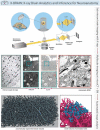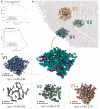Quantifying Mesoscale Neuroanatomy Using X-Ray Microtomography
- PMID: 29085899
- PMCID: PMC5659258
- DOI: 10.1523/ENEURO.0195-17.2017
Quantifying Mesoscale Neuroanatomy Using X-Ray Microtomography
Abstract
Methods for resolving the three-dimensional (3D) microstructure of the brain typically start by thinly slicing and staining the brain, followed by imaging numerous individual sections with visible light photons or electrons. In contrast, X-rays can be used to image thick samples, providing a rapid approach for producing large 3D brain maps without sectioning. Here we demonstrate the use of synchrotron X-ray microtomography (µCT) for producing mesoscale (∼1 µm 3 resolution) brain maps from millimeter-scale volumes of mouse brain. We introduce a pipeline for µCT-based brain mapping that develops and integrates methods for sample preparation, imaging, and automated segmentation of cells, blood vessels, and myelinated axons, in addition to statistical analyses of these brain structures. Our results demonstrate that X-ray tomography achieves rapid quantification of large brain volumes, complementing other brain mapping and connectomics efforts.
Keywords: Automated segmentation; X-ray microtomography; cell counting; electron microscopy; neocortex; neuroanatomy.
Conflict of interest statement
Authors report no conflict of interest.
Figures









References
-
- Arillo A, Peñalver E, Pérez-De La Fuente R, Delclòs X, Criscione J, Barden PM, Riccio ML, Grimaldi DA (2015) Long-proboscid brachyceran flies in Cretaceous amber (Diptera: Stratiomyomorpha: Zhangsolvidae). Syst Entomol 40:242–267. 10.1111/syen.12106 - DOI
-
- Bleckert AA, Brittain D, Borseth J, Bumbarger, Perkins DJ, Williams D, Takeno M, Reid D, Castelli D, Sullivan D, Keenan T, Reid C, Da Costa NDa (2016) Linking functional and anatomical circuit connectivity using fast parallelized TEM imaging. Abstract Number: 186.04. Society for Neuroscience Annual Meeting (SFN).
-
- Burns, R, Lillaney, K, Berger, DR, Grosenick, L, Deisseroth, K, Reid, RC, Roncal, WG, Manavalan, P, Bock, DD, Kasthuri, N, et al. (2013). The Open Connectome Project data cluster: scalable analysis and vision for high-throughput neuroscience. In Proc. of the 25th International Conference on Scientific and Statistical Database Management, 27 ACM. - PMC - PubMed
-
- Bushong EA, Johnson DD, Kim K-Y, Terada M, Hatori M, Peltier ST, Panda S, Merkle A, Ellisman MH (2015) X-ray microscopy as an approach to increasing accuracy and efficiency of serial block-face imaging for correlated light and electron microscopy of biological specimens. Microsc Microanal 21:231–238. 10.1017/S1431927614013579 - DOI - PMC - PubMed
Publication types
MeSH terms
Grants and funding
LinkOut - more resources
Full Text Sources
Other Literature Sources
